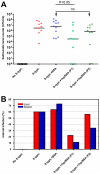Orally administered P22 phage tailspike protein reduces salmonella colonization in chickens: prospects of a novel therapy against bacterial infections
- PMID: 21124920
- PMCID: PMC2989905
- DOI: 10.1371/journal.pone.0013904
Orally administered P22 phage tailspike protein reduces salmonella colonization in chickens: prospects of a novel therapy against bacterial infections
Abstract
One of the major causes of morbidity and mortality in man and economically important animals is bacterial infections of the gastrointestinal (GI) tract. The emergence of difficult-to-treat infections, primarily caused by antibiotic resistant bacteria, demands for alternatives to antibiotic therapy. Currently, one of the emerging therapeutic alternatives is the use of lytic bacteriophages. In an effort to exploit the target specificity and therapeutic potential of bacteriophages, we examined the utility of bacteriophage tailspike proteins (Tsps). Among the best-characterized Tsps is that from the Podoviridae P22 bacteriophage, which recognizes the lipopolysaccharides of Salmonella enterica serovar Typhimurium. In this study, we utilized a truncated, functionally equivalent version of the P22 tailspike protein, P22sTsp, as a prototype to demonstrate the therapeutic potential of Tsps in the GI tract of chickens. Bacterial agglutination assays showed that P22sTsp was capable of agglutinating S. Typhimurium at levels similar to antibodies and incubating the Tsp with chicken GI fluids showed no proteolytic activity against the Tsp. Testing P22sTsp against the three major GI proteases showed that P22sTsp was resistant to trypsin and partially to chymotrypsin, but sensitive to pepsin. However, in formulated form for oral administration, P22sTsp was resistant to all three proteases. When administered orally to chickens, P22sTsp significantly reduced Salmonella colonization in the gut and its further penetration into internal organs. In in vitro assays, P22sTsp effectively retarded Salmonella motility, a factor implicated in bacterial colonization and invasion, suggesting that the in vivo decolonization ability of P22sTsp may, at least in part, be due to its ability to interfere with motility… Our findings show promise in terms of opening novel Tsp-based oral therapeutic approaches against bacterial infections in production animals and potentially in humans.
Conflict of interest statement
Figures






Similar articles
-
Homology between two different Salmonella phages: Salmonella enterica serovar Typhimurium phage P22 and Salmonella enterica serovar Anatum var. 15 + phageepsilon34.Virus Genes. 2004 Aug;29(1):87-98. doi: 10.1023/B:VIRU.0000032792.86188.fb. Virus Genes. 2004. PMID: 15215687
-
Carbohydrate binding of Salmonella phage P22 tailspike protein and its role during host cell infection.Biochem Soc Trans. 2010 Oct;38(5):1386-9. doi: 10.1042/BST0381386. Biochem Soc Trans. 2010. PMID: 20863318
-
Evaluation of a lytic bacteriophage, Φ st1, for biocontrol of Salmonella enterica serovar Typhimurium in chickens.Int J Food Microbiol. 2014 Feb 17;172:92-101. doi: 10.1016/j.ijfoodmicro.2013.11.034. Epub 2013 Dec 7. Int J Food Microbiol. 2014. PMID: 24361838
-
Tailspike interactions with lipopolysaccharide effect DNA ejection from phage P22 particles in vitro.J Biol Chem. 2010 Nov 19;285(47):36768-75. doi: 10.1074/jbc.M110.169003. Epub 2010 Sep 3. J Biol Chem. 2010. PMID: 20817910 Free PMC article.
-
Oral delivery of antibodies. Future pharmacokinetic trends.Clin Pharmacokinet. 1997 Apr;32(4):313-23. doi: 10.2165/00003088-199732040-00004. Clin Pharmacokinet. 1997. PMID: 9113439 Review.
Cited by
-
wksl3, a New biocontrol agent for Salmonella enterica serovars enteritidis and typhimurium in foods: characterization, application, sequence analysis, and oral acute toxicity study.Appl Environ Microbiol. 2013 Mar;79(6):1956-68. doi: 10.1128/AEM.02793-12. Epub 2013 Jan 18. Appl Environ Microbiol. 2013. PMID: 23335772 Free PMC article.
-
Animal Models to Translate Phage Therapy to Human Medicine.Int J Mol Sci. 2020 May 25;21(10):3715. doi: 10.3390/ijms21103715. Int J Mol Sci. 2020. PMID: 32466194 Free PMC article. Review.
-
Diversity and Function of Phage Encoded Depolymerases.Front Microbiol. 2020 Jan 10;10:2949. doi: 10.3389/fmicb.2019.02949. eCollection 2019. Front Microbiol. 2020. PMID: 31998258 Free PMC article. Review.
-
Bacteriophage-encoded virion-associated enzymes to overcome the carbohydrate barriers during the infection process.Appl Microbiol Biotechnol. 2017 Apr;101(8):3103-3119. doi: 10.1007/s00253-017-8224-6. Epub 2017 Mar 23. Appl Microbiol Biotechnol. 2017. PMID: 28337580 Free PMC article. Review.
-
Effect of Phage Spray on Hatchability and Chick Quality of Eggs Contaminated with Salmonella Typhimurium.Viruses. 2024 Aug 21;16(8):1338. doi: 10.3390/v16081338. Viruses. 2024. PMID: 39205312 Free PMC article.
References
Publication types
MeSH terms
Substances
LinkOut - more resources
Full Text Sources
Other Literature Sources
Miscellaneous

